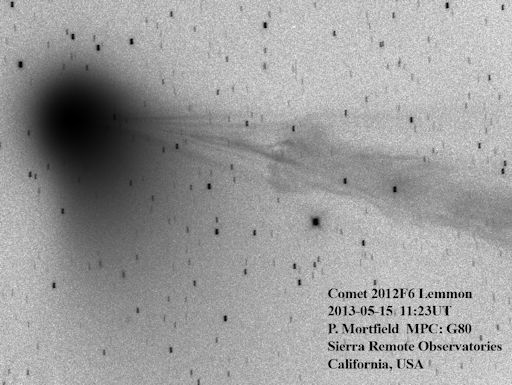Как мы сообщали ранее, комета C/2012 F6 (Леммон), которая в настоящее время держит курс на внешние области Солнечной системы, победила в космическом конкурсе красоты. Помимо Леммон, в конкурсе принимали участие кометы Айсон (ISON) и Панстаррс (Panstarrs). Леммон удалось победить благодаря красочному свечению и нитевидному хвосту.

© Gerald Rhemann | apod.nasa.gov
Цвет кометы определяется химическим составом ее ядра: циан ((CN) ядовитый газ) и двухатомный углерод (C). При освещении Солнцем в космическом вакууме оба вещества светятся зеленым светом. Официальный портал НАСА — «Астрономическое изображение дня» — провожает небесную гостью красивой фотографией, на которой комета предстает во всей своей красе.
Леммон пролетела на расстоянии 92 миллионов километров от Земли в середине апреля этого года. Впервые комета была зафиксирована 23 марта 2012 года. Наблюдения велись на горе Леммон, штат Аризона (США), отсюда и название небесного тела.
DISCONNECTION EVENT IN THE TAIL OF COMET LEMMON:Comet Lemmon (C/2012 F6), which is receding from the sun not far beyond the orbit of Earth, has just experienced a "disconnection event." A cloud of dusty plasma is propagating down the comet's tail, shown here in a photo taken by amateur astronomer Paul Mortfield on May 15th:

"I was pretty surprised to see this disconnection event when I processed the images," says Mortfield. "The comet is a challenge to photograph because it is so low in the sky at the start of morning twilight."
Disconnection events can be caused by CME impacts. A famous example is that of Comet Encke in 2007. Comet Lemmon, however, is not on the same side of the sun as active sunspot AR1748. It's hard to see how the recent X-flares can be responsible. Nevertheless, solar activity is high, so now is a good time to monitor comet tails. They are very sensitive to stormy space weather.
Comet Lemmon is a pre-dawn object for observers in the northern hemisphere. It is currently gliding alongside the Great Square of Pegasus in the eastern sky before sunrise. The 7th-magnitude comet is too faint to see with the naked eye, but it is visible in medium-to-large backyard telescopes. Observers with computerized GOTO 'scopes should point their optics here.
http://spaceweather.com/

